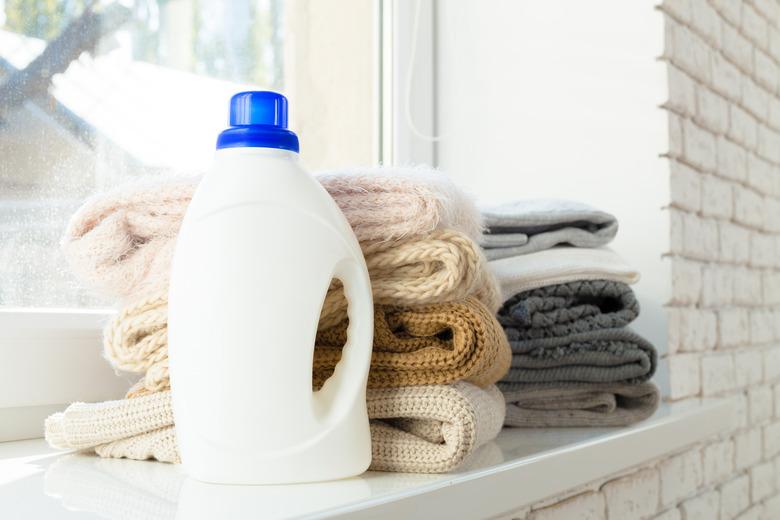How To Use Ammonia In The Laundry
Ammonia in laundry may seem unusual when considering today's modern detergents and solvents, but it was a laundry staple for many years. Often used for a variety of household cleaning tasks, ammonia also was — and still remains — an effective laundry additive that softens fabrics and brightens whites. Ammonia removes a variety of stains, including ink, blood, grease, rust, and grass.
You may find that you can remove stains and achieve an impressive level of cleanliness by adding ammonia to your laundry routine, but do so carefully. There is a right way and several wrong ways to go about adding ammonia to your laundry.
Curious about this laundry additive? Here are a few ways to use ammonia in your laundry routine.
Warning
Do not mix ammonia with chlorine bleach. When combined, the two produce a toxic gas. Skipping chlorine bleach when using ammonia in the laundry is a no-brainer, but bleach is found in other cleaning products as well, including some dish soaps. Before mixing ammonia with dish soap or detergent as a stain treatment, read the soap's product label carefully. If it lists chlorine bleach, chlorine, sodium hypochlorite, or hypochlorite on the product label, don't mix it with ammonia.
1. Treat Stains
We've all been there: you're wearing white clothes and inevitably you spill your coffee or bump into something and get a blood stain. But instead of busting out the bleach or stain pen, try ammonia, which makes a surprising number of stains disappear with minimal effort on your part. As with any stain-removing product, ammonia works best when applied to stains as soon as possible. The longer a stain is allowed to set, the harder it becomes to remove. It's also crucial to remove stains before you run the garment through your clothes dryer. Drying stains in the clothes dryer sets them, making them almost impossible to remove.
How to Treat Stains with Ammonia
|
Stain |
Formula |
Directions |
|
Sweat and pencil marks |
Undiluted ammonia |
Apply ammonia directly to the stain. Allow the ammonia to sit on the stain for a few minutes and then rinse. |
|
Blood, urine, and grass stains |
50/50 ammonia and water mixture |
Dab mixture generously on the stain before washing. |
|
Dried paint |
50/50 ammonia and turpentine mixture |
Thoroughly wet the stain several times and then launder the garment. |
|
Generic greasy (nonoily) stain |
Mix equal parts ammonia, water, and dishwashing liquid |
Spray the mixture directly onto the stain. Allow it to sit on the stain for about three minutes and then rinse. |
Warning
Only use clear ammonia in the laundry. Colored ammonia products can potentially stain fabric, especially lighter colors. Avoid using ammonia on wool or silk. Ammonia eats through proteins, including those that make up both of these fabrics.
2. Whiten Without Bleach
Chlorine bleach is often touted as the best way to whiten whites, but not all white fabrics can handle bleach. Bleach turns some materials yellow after the first use and can cause other damage to some fabrics. Ammonia isn't safe for wool or silk, but it is safe for most other fabrics. Using ammonia in laundry can also brighten both whites and colors without causing damage.
To use it, add 1/2 cup of ammonia to your washing machine along with your favorite laundry detergent. Make sure you read the detergent label first, however, to confirm that the detergent does not contain bleach. If it does not, it's perfectly safe to combine the ammonia and the detergent. The ammonia will brighten your colored clothes without harming bleach-sensitive materials or turning your favorite white shirt a dingy color.
3. Fix Scratchy or Nonabsorbent Towels
When your once-plush bath towel suddenly feels as if it's exfoliating your skin, it probably has hard water residue. The minerals in hard water cling to the towels, causing the terrycloth's piles to clump together. Ammonia dissolves these deposits, releasing the stuck-together fibers so the towel glides gently across your skin again.
If you notice that your towel is starting to smear water across your skin rather than wicking it away, it probably has a buildup of oils from repeated uses of fabric softener and dryer sheets. Ammonia dissolves the oil, refreshing the towel's absorbency.
Fix both issues by adding 1 cup of ammonia to your laundry cycle in lieu of detergent.
Tip
Prevent hard water buildup by investing in a water softener or adding 1/2 cup of baking soda to each load of laundry. To maintain your towels' absorbency, skip fabric softener and dryer sheets; instead, add 1/4 cup of distilled white vinegar to your washer's fabric softener dispenser to minimize static and increase softness.
4. Eliminate Grease
Did you splatter grease all over your favorite shirt when cooking or accidentally spill oil on your jeans when changing the oil in your car? Ammonia can help, but like all stain lifters, it works best when applied to the stain as quickly as possible. Dab the affected area with equal parts grease-fighting dish detergent and ammonia and launder with 1 cup of ammonia and your regular detergent. Again, make sure that your detergent products don't contain bleach.
Tip
Set your washer to run an extra rinse cycle to ensure all of the ammonia and excess soap suds rinse out of the fabric.
